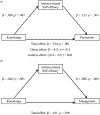Asthma Knowledge, Self-Efficacy, and Self-Management Among Rural Adolescents with Poorly Controlled Asthma
- PMID: 35880266
- PMCID: PMC9873834
- DOI: 10.1177/10598405221116017
Asthma Knowledge, Self-Efficacy, and Self-Management Among Rural Adolescents with Poorly Controlled Asthma
Abstract
Rural adolescents with asthma are a disparate group. Self-management is essential to asthma control. We describe asthma knowledge, self-efficacy, and self-management behaviors among 198 rural adolescents with poorly controlled asthma, exploring demographic differences; we also test the application of Social Cognitive Theory to asthma self-management examining if self-efficacy mediates associations between knowledge and self-management. Asthma knowledge and self-management were relatively poor in our sample, particularly among male and White adolescents; greater knowledge was significantly associated with better symptom prevention and management. Self-efficacy partially mediated the association between knowledge and symptom prevention, but not acute symptom management, suggesting that knowledge may not improve symptom prevention behaviors without confidence to implement such behaviors and that factors beyond knowledge and self-efficacy likely play a role in asthma self-management in this population. Addressing asthma knowledge and self-efficacy could improve self-management and, ultimately, enhance asthma control among rural adolescents with poorly controlled asthma.
Keywords: adolescents; asthma; prevention; rural health; self-efficacy; self-management; symptoms.
Conflict of interest statement
Declaration of Conflicting InterestsThe author(s) declared no potential conflicts of interest with respect to the research, authorship, and/or publication of this article.
Figures
References
-
- Akinbami LJ, Santo L, Williams S, Rechtsteiner EA, & Strashny A (2019). Characteristics of asthma visits to physician offices in the United States: 2012–2015 national ambulatory medical care survey. National Health Statistics Reports, 128(128), 1–20. https://www.ncbi.nlm.nih.gov/pubmed/31751210 - PubMed
-
- American Psychological Association. (2019). Racial and ethnic identity. Retrieved March 28, 2022 from https://apastyle.apa.org/style-grammar-guidelines/bias-free-language/rac...
-
- Bandura A (1994). Self-efficacy. In Ramachaudran VS (Ed.), Encyclopedia of human behavior (Vol. 4, pp. 71–81). Academic Press.
MeSH terms
Grants and funding
LinkOut - more resources
Full Text Sources
Medical


